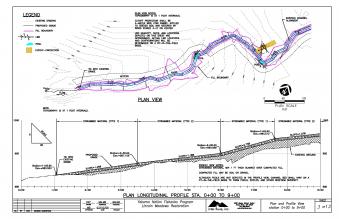Lincoln Meadows is a headwaters meadow for Toppenish Creek. Headwater meadows are important because they contain culturally important first foods and function as water storage to maintain summer base flows in streams, which supports aquatic life. Lincoln Meadows has been impacted by a variety of human related activities, such as roads and cattle grazing, that have severely degraded the meadow's capabilities.
Previous work on Lincoln Meadows included fencing the meadow for cattle exclusion and removing a road that bisected the meadow. A culvert located in the middle of the meadow was the cause of a severe headcut above and below the meadow. Other damages to the meadow were caused by overgrazing and physical trampling of the meadow by cattle. During this phase of restoration, the culvert was removed and the road was ripped and seeded. Keeping the cattle off the meadow was effective, but the headcut did not stabilize.
Yakama Reservation Watersheds Project (YRWP) staff determined to make a more effective attempt at bringing the water table back up and restoring the meadows natural hydrology.
- Improve ground water storage capability of the meadow
- Control livestock grazing
- Restore the water table
- Restore meadow hydrology
- Prevent future headcuts
YRWP staff worked with a hydraulic engineer consultant, Yakama Nation Tribal staff, and Bureau of Indian Affairs roads staff to develop a plan to restore the meadow back to its original grade.
The channel from the top of the meadow to the bottom of the meadow, a distance of approximately 830 feet, was filled to grade with large rock in certain places and then compacted with gravel and soil. We constructed and stabilized the stream banks using fabric lifts composed of gravel and soil materials. We then seeded the area with natural vegetation after construction was completed. Once the hydrology of the meadow is restored it is expected that native sedge communities will dominate the site and culturally important first foods such as Camas root and Yampa root will reestablish. As the climate changes, it is critical to restore meadows such as Lincoln Meadows to achieve adequate water storage.
Standing water is now present during summer months when water was not present pre-treatment. Standing water is evidence that the meadow is beginning to function properly. We have also observed abundant amphibian larvae and adults utilizing the water.
Due to the amount of snow that accumulates on Lincoln Meadow each winter, it is difficult to keep the livestock exclosure fence intact. To remedy this, YRWP plans to extend the buck and pole fence in place of the barb wire fence currently in use throughout the meadow. This action will effectively exclude livestock and feral horses to allow successful vegetation succession and reduce soil compaction.
YRWP staff monitor the site weekly (when accessable) to remove cattle and horses that have infiltrated the fence. Photopoints have also been set up to document changes in the meadow over time.
Status: Active
09/01/2010 - PresentProject Manager
-
Shannon Adams ,
Technical Services Coordinator
509-945-0754







